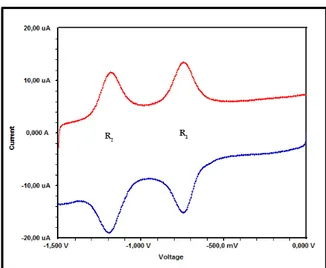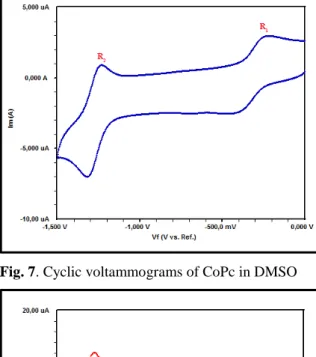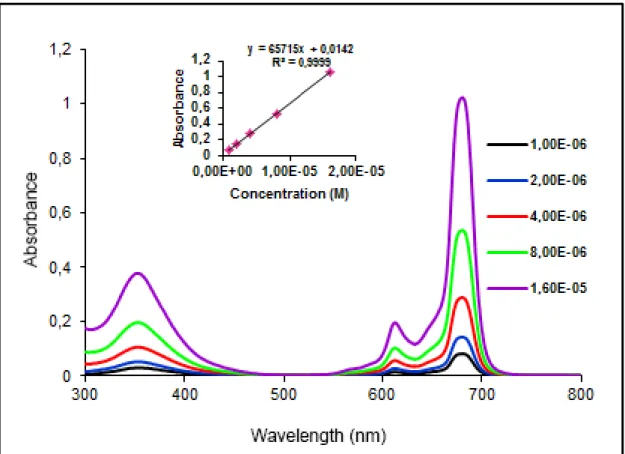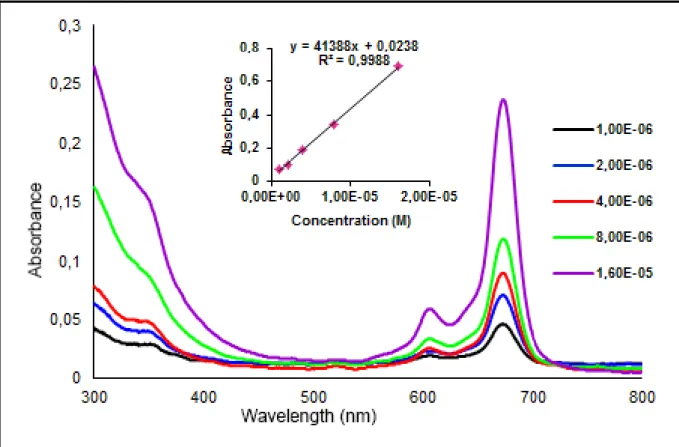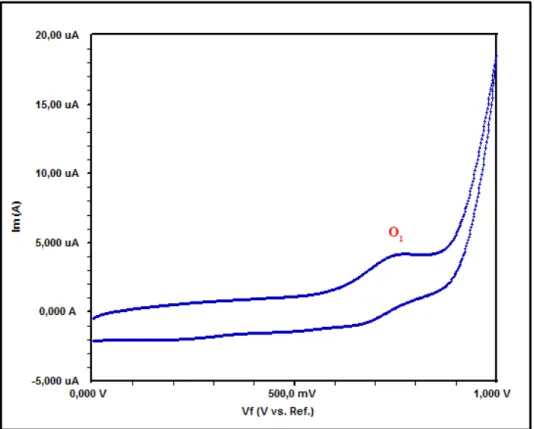Kabul (Accepted) :01/02/2017 Araştırma Makalesi
Piperazin Türevi İçeren Yeni Çinko (II) ve Kobalt (II) Ftalosiyaninlerin
Sentezi, Spektroskopik ve Elektrokimyasal Özelliklerinin İncelenmesi
Emine BAYRAKTAROGLU1, Pervin DEVECİ1
1Selçuk Üniversitesi, Fen Fakültesi, Kimya Bölümü, KONYA
e-mail: pervindeveci@gmail.com
Öz: Bu çalışmada, ter-butil4-(4-(3,4-disiyanofenoksi)fenil)piperazin-1-karboksilat grubu ihtiva eden yeni Zn(II) ve kobalt(II) ftalosiyanin kompleksleri elde edilerek, yapıları karakterize edilmiştir. Her iki kompleks te, DMF, DMSO, THF ve CHCl3 gibi polar çözücülerde çözünmektedir. Komplekslerin farklı çözücü ve
konsantrasyonlarda agregasyon özellikleri de incelenmiştir. DMF, DMSO ve THF çözücülerinde 1.10-5 M
konsantrasyona kadar her iki kompleksinde agregasyona uğramadığı, fakat CHCl3 çözücüsünde agregasyona
uğradıkları gözlenmiştir. Ayrıca komplekslerin elektrokimyasal özellikleri dönüşümlü voltametri ve kare dalga voltametri teknikleriyle incelenmiştir.
Anahtar kelimeler: Ftalosiyanin, Agregasyon, Zn(II) kompleks, Co(II) kompleks, Elektrokimya
Novel Zinc(II) and Cobalt(II) Phthalocyanines Bearing Piperazine Derivative: Spectroscopic and Electrochemical Properties
Abstract: In this manuscript, novel zinc (II) and cobalt (II) phthalocyanine complexes (ZnPc and CoPc) modified with tert-butyl 4-(4-(3,4-dicyanophenoxy)phenyl)piperazine-1-carboxylate substituents have been prepared and characterized. These complexes are solouble in many organic solvents such as DMF, DMSO, THF and CHCl3. Aggregation properties of complexes were examinated in different solvents and different
concentrations. Spectroscopic evaluation of the Pcs showed a monomeric behaviour evidenced by a single Q band for ZnPc and CoPc up to 1 .10-5 mol dm-3 in DMF, DMSO and THF as typical of metallo Pcs. In all studied
organic solvents except CHCl3, ZnPc and CoPc complexes were non-aggregated. Cyclic and square wave
voltammetries were used to evaluate the electrochemical properties of the synthesized complexes. Cyclic voltammetry showed two reduction couples and one oxidation peak for the two phthalocyanine complexes.
Keywords: Phthalocyanine, Aggregation, Zn(II) complex, Co(II) complex, Electrochemistry
1. Introduction
The study of Phthalocyanine compounds is one of the growing areas in macrocyclic chemistry (Arul et al., 2016; Shumba and Nyokong, 2016; Yanık et al., 2016) owing to their increased stability, improved spectroscopic characteristics and diverse coordination properties. They can form different types of coordination compounds with metal ions due to several
electron rich donor centers with unique structural and chemical properties. Considerable efforts have been devoted to the rational design and synthesis of functional phthalocyanines (Pcs) and their complexes, which are widely employed in the catalysis (Karaca, 2016; Medyouni et al., 2016) biological and environmental applications (Abramczyk et al., 2017; Wu et al., 2016), sensors (Klyamer et al., 2016; 41
Bayraktaroğlu and Deveci, Nisan (2017) 43 (1): 41-57
Kumar et al., 2015), medicine (Cong et al., 2015), dyes (Belekoukia et al., 2016; Sokolov et al., 2016), organic solar cells (Fukui et al., 2014; Williams et al., 2014) and photosensitizer for photodynamic therapy (PDT) (Duchi et al., 2016; Goksel, 2016; Oluwole et al., 2016; Pucelik et al., 2016). The low solubility and aggregation tendency of phthalocyanine molecules, has hindered the study of their structures and reactions (Shivashimpi et al., 2014). The attachments of the different functional groups to the Pcs increases the solubility and hinder the aggregation tendency, leading to significant advances in research.
In this study, two new Zn(II) and Co(II) complexes (ZnPc and CoPc) were obtained, and they were structurally and spectrally characterized, in detail for the first time to confirm the proposed structure using NMR (1H, 13C), FT-IR, UV–Vis, and
elemental analysis. Electrochemical properties of the metal complexes were investigated in DMSO solution containing 0.1 M tetrabutylammonium tetrafluoroborate (TBATFB) as supporting electrolyte by cyclic and square wave voltammetry. Within our knowledge, this is the first paper which contains the synthesis, characterization, and redox properties of ZnPc and CoPc compounds.
2. Materials and methods
All chemicals were purchased from commercial suppliers unless otherwise
specified. 4-Nitrophthalonitrile (Young and Onyebuagu, 1988) and tert-Butyl 4-(4-hydroxyphenyl)piperazine-l-carboxylate was prepared according to the literature procedures (Franc et al., 2009) and purified according to well-known literatures. The elemental analyses (C, H and N) were performed using a LECO-932 CHNSO model analyzer. NMR experiments were performed with a Varian Unity INOVA 500 spectrometer using a 5 mm ID-PFG probe at 298.15 K. Samples were dissolved in DMSO. Chemical shifts were reported in ppm relative to TMS for 1H NMR and 13C NMR spectra. The FT-IR spectra of solid samples were recorded on a Perkin-Elmer Spectrum 100 FT-IR spectrometer (Universal/ATR Sampling Accessary). UV-Vis spectra were obtained using Shimadzu
UV-1700 visible recording spectrophotometers. Melting points were
determined with an electrothermal apparatus and were not corrected.
2.1. Synthesis of Boc-Pip
tert-Butyl4-(4-(3,4-dicyanophenoxy)
phenyl) piperazine-1-carboxylate (Boc-Pip) was synthesized modification of the literature procedures (Zheng et al., 2013). A mixture of tert-Butyl 4-(4- hydroxyphenyl) piperazine-l-carboxylate (1.39 g, 5.0 mmol), 4-nitrophthalonitrile (0.87 g, 5.0 mmol), and anhydrous K2CO3 (1.38 g, 10 mmol) in
DMF (20 mL) was stirred at 40 °C for 48 h. The reaction mixture was poured into ice 42
water (200 mL) to give light red precipitate, which was collected by filtration, washed with water until pH 7 and dried in vacuum.
FT-IR (ν/cm-1): 3073 (Ar-H); 2976, 2863, 2827 (CH3, CH2); 2228 (CN); 1689 (C=O); 1597, 1566, 1504, 1485 (C=C); 1230 (C-N); 1170 (C-O). 1H NMR (400 MHz, DMSO-d 6, ppm, δ): 8.04 (d, 1H); 7.67 (d, 1H); 7.25-7.28 (dd, 1H); 7.02-7.07 (m, 4H); 3.44 (t, 4H); 3.09 t, 4H); 1.40 (s, 9H). 13C NMR (125 MHz, DMSO-d 6, δ): 28.49, 48.90, 79.46, 107.81, 115.90, 116.43, 116.97, 118.02, 121.48, 121.71, 122.31, 136.67, 146.31, 149.36, 154.27, 162.48. 2.2. Synthesis of ZnPc
A mixture of compound Boc-Pip (0.55 g, 1.5 mmol), anhydrous Zn(CH3COO)2
(0.23 g, 1.5 mmol) and a catalytic amount of 1,8-Diazabicyclo[5.4.0]undec-7-ene (DBU) in dry DMF (1 mL) was refluxed for 48 h. After cooling to room temperature, the reaction mixture was precipitated by adding methanol. The product was separated by filtration as a green solid which was washed several times with methanol and water. The residue was purified by a silica gel column chromatography using CHCl3/CH3OH
(14:1, v/v) as eluent. The obtained green solid was further purified by chromatography again using CH2Cl2/CH3OH (10:1, v/v) as eluent to give a dark-green solid ZnPc (0.155 g, 7.36%). FT-IR (ν/cm-1): 3043 (Ar-H); 2972, 2917, 2850, 2816 (CH3, CH2); 1691 (C=O); 1610 (C=N); 1505, 1466 (C=C); 1220 (C-N); 1161 (C-O). 1H NMR (400 MHz, DMSO-d 6, ppm, δ): 7.54-7.10 (m, 28H); 3.50 (t, 14H); 3.13 (t, 16H); 1.42 (s, 36H). 13C NMR (125 MHz, DMSO-d 6, ppm, δ): 28.68, 49.55, 79.61, 109.99, 117.96, 118.48, 118.81, 121.47, 121.65, 121.92, 123.68, 139.61, 148.71, 151.29, 154.47, 161.45. 2.3. Synthesis of CoPc
A mixture of compound Boc-Pip (0.55 g, 1.5 mmol), anhydrous CoCl2 (0.195 g, 1.5
mmol) and a catalytic amount of 1,8-Diazabicyclo[5.4.0]undec-7-ene (DBU) in dry DMF (1 mL) was refluxed for 24 h. After cooling to room temperature, the reaction mixture was precipitated by adding water. The product was separated by filtration as a green solid which was washed several times with water. The residue was purified by a silica gel column chromatography using CHCl3/CH3OH
(10:1, v/v) as eluent. A green band was collected and concentrated to give a crude product, which was purified by chromatography again using CH2Cl2/CH3OH (10:1, v/v) as eluent. FT-IR (ν/cm-1): 3042 (Ar-H); 2971, 2919, 2885, 2816 (CH3, CH2); 1689 (C=O); 1610 (C=N); 1505, 1463 (C=C); 1221 (C-N); 1162 (C-O). 43
Bayraktaroğlu and Deveci, Nisan (2017) 43 (1): 41-57
2.4. Electrochemical measurements
All electrochemical experiments were performed using a Gamry Reference 600 workstations (Gamry, Pennsylvania, USA) electrochemical analyzer (Model 600C series) equipped with BAS C3 cell stand. The working electrode was a bare, glassy carbon disk (BAS Model MF-2012) with a geometric area of 0.027 cm2. The reference electrode was Ag/Ag+ (0.01 M) in nonaqueous media, and the counter electrode was a Pt wire. The glassy carbon electrodes were prepared by first polishing them first with fine, wet emery papers (grain size 4000) (Buehler, Lake Bluff, IL, USA) and then 0.1 µm and 0.05 µm alumina slurry on polishing pads (Buehler, Lake Bluff, IL, USA) in order to give them a mirror-like appearance. The electrodes were sonicated for 5 min in water and in a 50:50 (v/v)
isopropyl alcohol and acetonitrile (IPA+MeCN) solution purified over activated carbon. Prior to the electrochemical experiments, the electrodes were dried with an argon gas stream, and the solutions were purged with pure argon gas (i.e., 99.999%) for at least 10 minutes; additionally, an argon atmosphere was maintained over the solution during the experiments.
3. Results and discussion
3.1. Synthesis and Characterization
The tert-Butyl 4-(4-hydroxyphenyl)
piperazine-l-carboxylate substituted phthalonitrile derivative (Boc-Pip) was
obtained by reaction of tert-Butyl 4-(4- hydroxyphenyl) piperazine-l-carboxylate with 4-nitrophthalonitrile in the presence of K2CO3 (Scheme 1). The reaction was
carried out in DMF.
Scheme 1. Synthesis of ZnPc and CoPc; i: DBU, Zn(CH3COO)2 or CoCl2
Phthalonitrile derivative (Boc-Pip) was respectively treated with the zinc(II) acetate or cobalt (II) chloride in DMF in the presence of DBU to afford corresponding tetra-substituted phthalocyanine derivatives (ZnPc and CoPc) (Scheme 1). The ZnPc and CoPc were washed with methanol, water and ethanol and then were purified by column chromatography by using chloroform / methanol or dichloromethane / methanol as eluent. ZnPc and CoPc have good solubility in many polar organic solvents, such as DMSO, DMF, THF and CHCl3. Their chemical structures were fully
characterized by elemental analysis, FT-IR, 1H NMR, 13C NMR. The FT-IR spectrum of Boc-Pip, CN stretching peak was seen at 2228 cm−1. This peak disappeared in the case of ZnPc and CoPc, indicative of phthalocyanine formation. The C–Harom and C–Haliph vibrations were
observed at about 3043-3073 cm−1 and 2976-2816 cm−1, respectively.
The 1H NMR spectra of Boc-Pip (Fig. S1) and ZnPc (Fig. S2) were recorded in DMSO-d6. In the 1H-NMR spectra of
Boc-Pip, a singlet signal at 8.89 ppm concerning the -OH group disappeared, and new chemical shifts at about 7.25-8.04 ppm was observed that could be assigned to the new aromatic ring. The chemical shifts of N– CH2 protons were observed at about
3.44-3.50 and 3.09-3.13 ppm as triplets for Boc-Pip and ZnPc.
The 1H NMR and 13C NMR spectra of
ZnPc are broader than the corresponding NMR signals in the starting dinitrile because of the aggregation of phthalocyanine cores (Bilgin et al., 2007; Kantar et al., 2015)
The 13C-NMR spectra of Boc-Pip (Fig. S3) and ZnPc (Fig. S4) show 16 different carbon atoms. In other respects, 1H NMR spectra and 13C NMR of CoPc could not be measured due to the paramagnetic cobalt(II) center (Saka et al., 2013). The detailed information belonging to the chemicals shifts was given in the experimental section.
Spectroscopic evaluation was performed in several solvents such as, DMSO, DMF, THF and CHCl3. In the
UV-vis spectra, ZnPc (Fig. 1) and CoPc (Fig. 2) show an intense single Q band absorption of π-π* transition at around 678-683 nm and 664-673 nm respectively in the pure solvents. B (Soret) bands of the complexes were observed in the UV region at about 350 nm. The two complexes showed similar absorption features in solutions.
3.2. Aggregation studies
The aggregation properties of the phthalocyanines ZnPc and CoPc were investigated at different concentrations ranging from 1.10-6-16.10-6 M in DMSO, DMF, THF and CHCl3. The results are
given in Table 1. The UV-Vis spectra of ZnPc and CoPc compounds in DMSO, DMF, THF (Fig. 1,2) exhibit an intense and sharp Q-band at about 673-683 nm. But in 45
Bayraktaroğlu and Deveci, Nisan (2017) 43 (1): 41-57
CHCl3 solvent, the splitting of Q band was
observed at 720 and 692 nm for ZnPc, 604, 667 and 720 nm for CoPc indicating the structure with non-degenerate D2h symmetry
of metal free. The results in DMF solutions investigated at different concentrations is given as an example in Fig. 3 and 4. The Q-band strictly obeys the Lambert-Beer law. The results in DMSO and THF solutions is given in Fig. S5-S8.
Table 1. UV–Vis results in various solvents
Compound Solvent Q-Band λmax,(nm) log ε B-Band λmax,(nm) log ε ZnPc DMSO 683 5.05 353 4.67 ZnPc DMF 681 4.83 353 4.38 ZnPc THF 678 5.04 348 4.68 ZnPc CHCl3 692, 720 3.65, 3.67 370 3.80 CoPc DMSO 664 4.68 333 4.48 CoPc DMF 667 4.64 327 4.54 CoPc THF 673 4.19 353 3.98 CoPc CHCl3 604, 667,720 4.55 350 4.23 3.3. Electrochemical studies Cyclic voltammetry (CV) is a powerful method for investigating the electrochemical properties. The
electrochemical properties of metallophthalocyanines have been studied
extensively for their possible applications, including organic conductors, chemical
sensors, electrocatalysts, and electrochromic materials (Prakash Singh et al., 2010). CV and Square Wave Voltammetry (SWV) experiments were performed for ZnPc and CoPc in DMSO using a GCE, a Pt gauze counter electrode and an Ag/AgCl reference electrode at ambient temperature. The cyclic and square wave voltammograms of ZnPc and CoPc are given in Figs. 5-6 and Figs. 7-8, respectively. The experimental results of electrochemical analyses and assignments are given in Table 2. The voltammograms given in Fig. 5 and Fig 7 were recorded at 100 mV s-1 with in the 0 V to -1.5 V potential window, and demonstrated two pair of symmetric peaks,
According to the ΔEp values, ZnPc
gives two quasi-reversible reduction (R1 at
-0.78 V, ΔEp = 130 mV and R2 at -1.18 V,
ΔEp = 140 mV), and one irreversible
oxidation reactions (Fig. S9, Fig. S10) (O1
at 0.74 V). The other complex, CoPc, behaved similarly. These two reduction couples are connected with the ring reduction processes, namely [M(II)Pc(-2)] / [M(II)Pc(-3)]- and [M(II)Pc(-3)]-/ [M(II)Pc(-4)]2- (M: Zn, Co) respectively (Acar et al., 2014; Çakır et al., 2015; Ömeroğlu et al., 2014). Also, the peak currents increased linearly with the square root of the scan rates for ZnPc (Fig. 10) and CoPc (Fig. 11).
Table 2. Voltammetric results in DMSO–TBATFB Compound Redox couple La bel Epa (V) Epc (V) ΔE p (m V) E1/2 (V)a ZnPc [Zn(II)Pc(-2)] / [Zn(II)Pc(-3)] -R1 -0.8 4 -0.7 1 130 -0.78 ZnPc [Zn(II)Pc(-3)]-/ [Zn(II)Pc(-4)] 2-R2 -1.1 1 -1,2 5 140 -1.18 CoPc Co(II)Pc(-2) / [Co(II)Pc(-3)] -R1 -0.5 0 -0.2 2 280 -0.36 CoPc [Co(II)Pc(-3)]-/ [Zn(II)Pc(-4)] 2-R2 -1.3 2 -1.2 3 90 -1.28
Epa (anodic peak potential), Epc (cathodic peak
potential),
a E
1/2 = (Epa+Epc)/2 for reversible or quasi-reversible
processes.
4. Conclusion
We have described the preparation, spectroscopic and electrochemical studies of novel zinc (II) and cobalt (II) phthalocyanine compounds (ZnPc and CoPc) modified with four tert-butyl 4-(4-
(3,4-dicyanophenoxy)phenyl)piperazine-1-carboxylate moieties. Spectroscopic evaluation of the Pcs showed a monomeric behaviour in DMF, DMSO and THF. In all studied organic solvents except CHCl3,
ZnPc and CoPc complexes were non-aggregated. The redox behaviour was showed on the ring centered reduction processes for all complexes.
Acknowledgement
We thank the Research Foundation of The Selcuk University (BAP) for financial support of this work. This manuscript was performed under master thesis.
References
Abramczyk H, Brozek-Pluska B, Surmacki J, Tondusson M Freysz E (2017). Photostability of biological systems—Femtosecond dynamics of zinc tetrasulfonated phthalocyanine at cancerous and noncancerous human Breast tissues. Journal of Photochemistry and Photobiology A: Chemistry 332: 10-24.
Acar İ, Arslan T, Topçu S, Aktaş A, Şen S Serencam H (2014). Synthesis and electrochemistry of metallophthalocyanines bearing {4-[(2E)-3-(3,4,5-trimethoxyphenyl)prop-2-enoyl]phenoxy} groups. J Organomet Chem 752: 25-29. Arul A, Christy M, Oh MY, Lee YS Nahm KS (2016). Nanofiber Carbon-Supported
Phthalocyanine Metal Complexes as Solid Electrocatalysts for Lithium-Air Batteries. Electrochimica Acta 218: 335-344.
Bayraktaroğlu and Deveci, Nisan (2017) 43 (1): 41-57
Belekoukia M, Ploumistos A, Sygellou L, Nouri E, Tasis D Lianos P (2016). Co–N doped reduced graphene oxide used as efficient electrocatalyst for dye-sensitized solar cells. Solar Energy Materials and Solar Cells 157: 591-598.
Bilgin A, Ertem B Gök Y (2007). Highly Organosoluble Metal-Free Phthalocyanines and Metallophthalocyanines: Synthesis and Characterization. European Journal of Inorganic Chemistry 2007: 1703-1712.
Cong F, Wei Z, Huang Z, Yu F, Liu H, Cui J, Yu H, Chu X, Du X, Xing K Lai J (2015). Characteristic absorption band split of symmetrically tetra-octyloxy metal phthalocyanines. Dyes and Pigments 120: 1-7.
Çakır D, Bekircan O Biyiklioglu Z (2015). 1,2,4-Triazole-substituted metallophthalocyanines carrying redox active cobalt(II), manganese(III), titanium(IV) center and their electrochemical studies. Synthetic Metals 201: 18-24.
Duchi S, Ramos-Romero S, Dozza B, Guerra-Rebollo M, Cattini L, Ballestri M, Dambruoso P, Guerrini A, Sotgiu G, Varchi G, Lucarelli E Blanco J (2016). Development of near-infrared photoactivable phthalocyanine-loaded nanoparticles to kill tumor cells: An improved tool for photodynamic therapy of solid cancers. Nanomedicine: Nanotechnology, Biology, And Medicine.
Franc G, Turrin C-O, Cavero E, Costes J-P, Duhayon C, Caminade A-M Majoral J-P (2009). gem-Bisphosphonate-Ended Group Dendrimers: Design and Gadolinium Complexing Properties. European Journal of Organic Chemistry 2009: 4290-4299.
Fukui H, Nakano S, Uno T, Dao Q-D, Saito T, Fujii A, Shimizu Y Ozaki M (2014). Miscibility in binary blends of non-peripheral alkylphthalocyanines and their application for bulk-heterojunction solar cells. Organic Electronics 15: 1189-1196. Goksel M (2016). Synthesis of asymmetric zinc(II) phthalocyanines with two different
functional groups & spectroscopic properties and photodynamic activity for photodynamic therapy. Bioorganic & Medicinal Chemistry 24: 4152-4164.
Kantar C, Akal H, Kaya B, Islamoğlu F, Türk M Şaşmaz S (2015). Novel phthalocyanines containing resorcinol azo dyes; synthesis, determination of pKa values, antioxidant, antibacterial and anticancer activity. J Organomet Chem 783: 28-39.
Karaca H (2016). Redox chemistry, spectroelectrochemistry and catalytic activity of novel synthesized phthalocyanines bearing four schiff bases on the periphery. J Organomet Chem 822: 39-45.
Klyamer DD, Sukhikh AS, Krasnov PO, Gromilov SA, Morozova NB Basova TV (2016). Thin films of tetrafluorosubstituted cobalt phthalocyanine: Structure and sensor properties. Applied Surface Science 372: 79-86.
Kumar A, Brunet J, Varenne C, Ndiaye A, Pauly A, Penza M Alvisi M (2015). Tetra-tert-butyl copper phthalocyanine-based QCM sensor for toluene detection in air at room temperature. Sensors and Actuators B: Chemical 210: 398-407.
Medyouni R, Elgabsi W, Naouali O, Romerosa A, Sulaiman Al-Ayed A, Baklouti L Hamdi N (2016). One-pot three-component Biginelli-type reaction to synthesize 3,4-dihydropyrimidine-2-(1H)-ones catalyzed by Co phthalocyanines: Synthesis, characterization, aggregation behavior and antibacterial activity. Spectrochimica Acta. Part A, Molecular and Biomolecular Spectroscopy 167: 165-174.
Oluwole DO, Uddin I, Prinsloo E Nyokong T (2016). The effects of silica based nanoparticles on the photophysicochemical properties, in vitro dark viability and photodynamic therapy study of zinc monocarboxyphenoxy phthalocyanine. Journal of Photochemistry and Photobiology A: Chemistry 329: 221-231.
Ömeroğlu İ, Arslan T, Bıyıklıoğlu Z Tosun G (2014). Novel pthalocyanines bearing 4-ferrocenylphenoxy substituents and their electrochemistry. J Organomet Chem 749: 261-265.
Prakash Singh S, Emin S Loukanov A (2010). Synthesis Of Highly Soluble Phthalocyanine From A New Phthalonitrile Under Mild Conditions. Advanced Materials Letters 1: 148-150.
Pucelik B, Gurol I, Ahsen V, Dumoulin F Dabrowski JM (2016). Fluorination of phthalocyanine substituents: Improved photoproperties and enhanced photodynamic efficacy after optimal micellar formulations. European Journal of Medicinal Chemistry 124: 284-298.
Saka ETb, Acar İ, Biyiklioğ lu Z, Kantekin H Kani İ (2013). Synthesis and characterization of peripheral and non-peripheral substituted Co(II) phthalocyanines and their catalytic activity in styrene oxidation. Synthetic Metals 169: 12-17.
Shivashimpi GM, Pandey SS, Hayat A, Fujikawa N, Ogomi Y, Yamaguchi Y Hayase S (2014). Far-red sensitizing octatrifluorobutoxy phosphorous triazatetrabenzocorrole: Synthesis, spectral characterization and aggregation studies. Journal of Photochemistry and Photobiology A: Chemistry 289: 53-59.
Bayraktaroğlu and Deveci, Nisan (2017) 43 (1): 41-57
Shumba M Nyokong T (2016). Development of nanocomposites of phosphorus-nitrogen co-doped graphene oxide nanosheets and nanosized cobalt phthalocyanines for electrocatalysis. Electrochimica Acta 213: 529-539.
Sokolov VS, Gavrilchik AN, Kulagina AO, Meshkov IN, Pohl P Gorbunova YG (2016). Voltage-sensitive styryl dyes as singlet oxygen targets on the surface of bilayer lipid membrane. Journal of Photochemistry and Photobiology B, Biology 161: 162-169. Williams G, Sutty S, Klenkler R Aziz H (2014). Renewed interest in metal phthalocyanine
donors for small molecule organic solar cells. Solar Energy Materials and Solar Cells 124: 217-226.
Wu H, Guo L, Zhang J, Miao S, He C, Wang B, Wu Y Chen Z (2016). Polyelectrolyte-free layer by layer self-assembled multilayer films of cationic phthalocyanine cobalt(II) and carbon nanotube for the efficient detection of 4-nitrophenol. Sensors and Actuators B: Chemical 230: 359-366.
Yanık H, Al-Raqa SY, Aljuhani A Durmuş M (2016). The synthesis of novel directly conjugated zinc(II) phthalocyanine via palladium-catalyzed Suzuki–Miyaura cross-coupling reaction and its quaternized water-soluble derivative: Investigation of photophysical and photochemical properties. Dyes and Pigments 134: 531-540.
Young JG Onyebuagu W (1988). Synthesis and Characterization of Di-disubstituted Phthalocyanines. The Journal of Organic Chemistry 55: 2155-2159.
Zheng B-Y, Zhang H-P, Ke M-R Huang J-D (2013). Synthesis and antifungal photodynamic activities of a series of novel zinc(II) phthalocyanines substituted with piperazinyl moieties. Dyes and Pigments 99: 185-191.
Fig.1. UV–Vis spectrum of 1.10-5 M ZnPc in DMSO,
THF, CHCl3 and DMF
Fig.2. UV–Vis spectrum of 1.10-5 M CoPc in DMSO,
THF, CHCl3 and DMF
Fig. 3. UV-Vis spectrum of ZnPc in DMF
Fig. 4. UV-Vis spectrum of CoPc in DMF
Fig. 5. Cyclic voltammograms of ZnPc in DMSO
Fig. 6. SWV of ZnPc for cathodic scan
Bayraktaroğlu and Deveci, Nisan (2017) 43 (1): 41-57
Fig. 7. Cyclic voltammograms of CoPc in DMSO
Fig. 8. SWV of CoPc for cathodic scan
Fig. 9. CV of ZnPc at different scan rates
Fig. 10. CV of CoPc at different scan rates
Fig. S1. 1H NMR spectra of Boc-Pip
Fig. S2. 1H NMR spectra of ZnPc
Bayraktaroğlu and Deveci, Nisan (2017) 43 (1): 41-57
Fig. S3. 13C NMR spectra of Boc-Pip
Fig. S4. 13C NMR spectra of ZnPc
Fig. S5. UV-Vis Spectra of ZnPC ( DMF)
Fig. S6. UV-Vis Spectra of ZnPC ( DMSO)
Bayraktaroğlu and Deveci, Nisan (2017) 43 (1): 41-57
Fig. S7. UV-Vis Spectra of CoPC (THF)
Fig. S8. UV-Vis Spectra of CoPC (DMSO)
Fig. S9. Cyclic voltammograms of ZnPc in DMSO
Fig. S10. Cyclic voltammograms of CoPc in DMSO
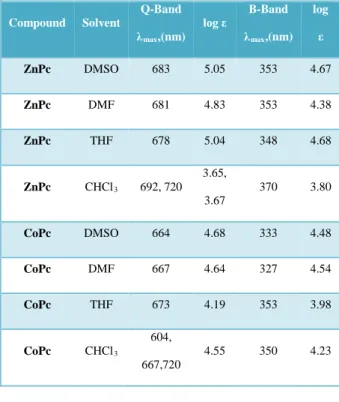
![Table 2. Voltammetric results in DMSO–TBATFB Compound Redox couple La bel E pa (V) E pc (V) ΔEp(m V) E 1/2 (V)a ZnPc [Zn(II)Pc(-2)] / [Zn(II)Pc(-3)] -R 1 -0.84 -0.71 130 -0.78 ZnPc [Zn(II)Pc(-3)]-/ [Zn(II)Pc(-4)] 2-R 2 -1.11 -1,25](https://thumb-eu.123doks.com/thumbv2/9libnet/4903892.98258/7.892.98.435.133.477/table-voltammetric-results-tbatfb-compound-redox-couple-δep.webp)
